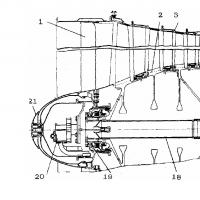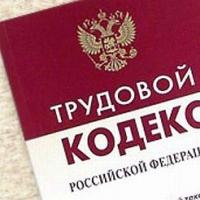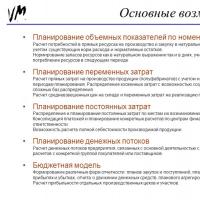Individual tailoring from leather. Sewing leather goods Atelier for sewing men's leather clothing
Rare material can compete with genuine leather in terms of external nobility and practicality in wearing, so tailoring from this raw material will always be in price, and products are in demand. However, not every tailor can sew leather. Sewing in terms of technology, tools and consumables used is significantly different from the manufacture of fabric products. To sew a specific item, you need to know what leather raw material is suitable for it.
Types and uses of natural leathers
Leather from different parts of animal skins, varying in thickness, softness, tanning method and surface finishing, is used in its own way. Leather suitable for belts does not make a good jacket. Effective externally, haberdashery raw materials are not suitable for shoes. Factory-produced leathers are initially divided by appointment .
There are leathers specially designed for the production of certain products:
- saddlery- dense, wear-resistant, suitable for making belts, bags, and individual accessories;
- shoe- divided into soft, elastic leather for the top of products and a harder, abrasion-resistant material for the bottom (insoles, soles);
- clothing and haberdashery- quite thin, but durable, distinguished by a wide choice of textures, colors and decorative trims, they allow you to sew a wide variety of clothes from summer dresses to warm coats and stylish accessories.
What animal skin is used for sewing products?
When choosing leather for sewing products, it is of great importance type of feedstock . Natural leather is produced from the skins of various animals:
- Cattle(calves, bulls, cows, buffaloes). Due to its large area, strength and elasticity, this material is most often used for sewing shoes, outerwear and bags.
- Pork, inferior in quality, but cheap. It is often used as a shoe lining. Modern processing technologies make this raw material more attractive and make it possible to obtain soft pork suede and other materials suitable for the production of various clothing and haberdashery.
- Sheep, delicate and very soft to the touch. Small-sized sheep skins are most often used for gloves and are valued in the manufacture of bags, accessories and jewelry. Less commonly, this rather expensive leather is used for sewing jackets and jackets.
- Goat, thin, soft, with a beautiful wave-like pattern on the surface. Unlike sheep leather, this leather is denser, uniform in thickness and waterproof, which is valued in the manufacture of shoes, outerwear and haberdashery.
Leather also has high technological and consumer properties. deer, elk And young stallions. Luxury clothing and shoes are made from this raw material. Exotic, but suitable for sewing, leather raw materials - skins of reptiles (crocodile, python, monitor lizard), fish (eel, carp, pike), stingray and ostrich.
Features of leather sewing technology
In addition to the correct selection of raw materials for a specific product, it is necessary to take into account that sewing leather items differs significantly from making similar products from fabric. The technology of working with leather in clothing production has a number of features:
- it is necessary to use special cutting and sewing tools;
- paired parts of products are cut in the same direction to avoid different degrees of stretching;
- the skin should not be chipped with pins;
- the seams of the parts being connected are not ironed, but glued;
- buttons and metal fittings require additional reinforcement.
There are nuances to working with thick leather, which often bristles at the folds, or very thin leather, which can tear when several stitches are applied in one place. When making suede products, the direction of the pile is taken into account. Leather is sewn by highly qualified specialists who are able to make straight lines and seams the first time. An unsuccessful seam in a visible place will hopelessly ruin the product, since it cannot be ripped open without a needle mark on the surface of the material.
What tools and materials are used for sewing leather?
Sufficiently thin and soft leather can be sewn on a regular machine; thicker and denser leather requires professional equipment. The stitch width is set almost to the maximum to avoid tearing the skin from frequent punctures. For the same reason, seam tacks are not done in reverse. When sewing leather products, specially designed for this purpose are used:
- Needles with a two- or four-sided tip, easier to pierce the skin with a minimal hole.
- Sewing feet with a roller or roller instead of a flat sole for better glide over the surface of the skin.
- Cutting (shoe) knife, which is used to cut the skin, placing a wooden or plastic base under it. For cutting thin leather into one piece, ordinary tailor's scissors are suitable. The advantage of the knife is the ability to cut several leathers laid on top of each other at once.
- Threads increased strength and elasticity with low torsion.
- Glue, most often rubber. It should be thick enough so as not to spoil the front surface if it soaks through the skin.
Thin leather can be smoothed without steam from the inside out with a slightly heated iron through a dry cloth, having first tried it on an unnecessary piece. Without experience in such work, the skin can shrink and harden from overdrying. Holes for various accessories of leather products are reinforced with an additional piece of material or adhesive fabric. Buttons are sewn to the front surface with a subbutton on the wrong side of the product. These measures are designed to extend the already long service life of clothing, shoes and accessories made of genuine leather.
It is possible, but subject to certain rules. Working with natural leather is difficult, but interesting and educational.
: types, description, care
Preparing and cutting leather parts
Genuine leather is sold in specialized stores in pieces of different sizes and shapes. Therefore, when going to the store, take with you the pattern of the product you are going to sew. So you definitely won’t go wrong with the amount of material needed.Before you start cutting a leather product, sew a fabric sample, making all changes to the paper pattern. Or take a proven model that does not require any adjustments.
Cut the leather, spreading it out in one layer. Cut paired parts, for example, right and left sleeves, in a mirror image.
Genuine leather stretches more in the transverse direction than in the longitudinal direction, therefore, in order to save money, you cannot cut out one shelf along and the other across.
You can cut leather with tailor's scissors, a regular blade,

Cover one part of it in cork.

But it is best to cut out parts from genuine leather with a special knife on a plastic or wooden backing.
When cutting suede, be sure to take into account the direction of the pile; it should always be directed from top to bottom.
The details of the paper pattern are attached to the skin with adhesive tape (painting tape will do), the contours are marked with a ballpoint pen with a thin rod or
Marker pen.
Seam allowances on cuts should be the same width and be 1.5 cm, the bottom of the product and sleeves should be at least 5 cm.
Parts of a genuine leather product cannot be basted in the usual way, as needle marks will remain on the leather. For the same reason, you should not rip apart sewn parts in order, for example, to adjust a pattern. Make all adjustments before you start sewing.
Before stitching, fasten the parts with regular paper clips, paper clips or special leather clips. The latter can be purchased in specialized stores.
If you want to use tailor's pins, then fasten the parts with them, perpendicular to the seam line, not reaching it a couple of millimeters. After stitching, carefully remove the pins.
Wet-heat treatment of natural leather
To “smooth out” the seam allowances in a product made of genuine leather, spread them in different directions and gently tap them with a wooden, rubber or regular small hammer. The allowances can then be glued to the product with special leather glue.If the leather is thin and soft, the allowances can be smoothed with an iron through cotton fabric or an ironing iron.
Important! Before ironing natural leather, first perform this operation on an unnecessary flap. Be sure to turn off the steam function. Any natural leather shrinks when exposed to damp heat treatment.
read the website
How to sew genuine leather on a household sewing machine
Needles
To work with leather, use only special thin triangular needles. They are available for both sewing machines and handmade work. In this case, choose the needle size depending on the thickness of the material.
Threads
Strong thin or specialized threads for leather are suitable for sewing leather on a sewing machine. It is very important to choose the right threads, otherwise they will break during the sewing process.
Silk, viscose or synthetic are suitable. For information about the permissible thread thickness, be sure to refer to the instructions for your machine.
Paws
Install a Teflon or roller foot on your sewing machine. The latter serves as an additional upper conveyor and helps to avoid displacement of parts relative to each other. Currently on sale there is a hybrid of a Teflon foot with a roller.
If you have neither one nor the other, place tissue or silk paper under the leather while sewing, which can then be easily removed. In this case, your sewing machine will promote natural leather well.
And instead of the upper conveyor, a strip of thin and fine sandpaper will help out, which should be placed under the foot with the working surface down. Be sure to first test on an unnecessary piece of scrap.
Stitch length, bartacks
To sew leather, set the stitch length to almost the maximum stitch length on your sewing machine, 4-5 mm. Stitches that are too small greatly perforate natural leather, which can result in thin material tearing along the seams.Stitching on leather goods

Topstitching on leather products is done without basting, with long stitches, at slow speed, parallel to the seam, guided by the edge of the sewing machine foot. In this case, a thicker needle and special threads are used for stitching. For example, you sewed a product with a needle No. 80, but for stitching take a No. 90.
First, before sharpening, tap thick sections with a hammer to make them flat.
: Master Class
Padding materials
Places that may stretch during wear are reinforced with low-temperature doublerin or non-woven fabric. Be sure to reinforce the armholes, neckline and shoulder seams.It is better to take a special interlining for leather Le 420, which is glued with an iron. It is better to duplicate very thin leather with non-woven fabric over the entire area of the material.
To strengthen, for example, the handles of a bag, you can use non-woven formband or strips cut along the width of the parts of the handles from low-temperature dublerin for leather.
The lining is sewn to leather products in the same way as to products made from ordinary fabric. It performs not only an aesthetic function, but also helps maintain the shape of the product.You should always sew buttons on a leather product in pairs - one on the front side and a small flat one on the back.
Pockets and zippers are fixed with a glue stick, seam allowances and hems are glued with textile glue.
: video tutorial on the site
Source and photo: website; Yulia DekanovaGenuine leather is a unique material that is invariably popular among fashionistas and fashionistas around the world. These clothes make you feel stylish and confident. Things should fit well to the figure and form a perfect silhouette. You can get such a result only if you order leather tailoring by contacting experienced specialists.
Only high quality models
The leather sewing studio “Moda Moscow” invites you to make your dream come true and become the owner of a model that will be ideal in cut, length and additional accessories. Leather is chosen by practical and self-confident people who are accustomed to choosing only the best.
Contact a leather sewing studio in Moscow if you value high quality and are interested in:
- Jacket. A leather jacket is always a timeless classic. This item will be an elegant addition to any outfit and will highlight the dynamic character of the owner.
- Skirt. The style and practicality of leather skirts helps them remain at the peak of every fashion season. They will be appropriate at a party, first date and in the office.
- Cloak. With such leather clothes you can look great in the cold season. Products very often have a fur lining. They add a touch of luxury to your look.
Sewing leather goods in Moscow involves the use of high-quality materials. Our employees have experience working with very expensive and valuable fabrics and are attentive to all your wishes. Particularly popular now is sewing outerwear from reptile skin according to individual sketches.
Placing an order
You can order leather goods from our atelier today! Complete your wardrobe with stylish and exclusive items that are highly valued by all fashionistas in Moscow! We have affordable prices for any services. The craftsmen also repair old clothes taking into account your new needs. Contact us - you are always welcome!
The portal contains telephone numbers and addresses of Moscow ateliers where you can order the tailoring of leather goods. We suggest studying the prices for leather tailoring services, presented in tables convenient for comparison. This will allow you to select an option in the optimal price category that meets the wishes of customers.
The collected reviews from visitors to the portal will help you find good tailors from whom you can order clothes made from genuine leather, which will never go out of fashion, delighting the owners with practicality and convenience.
Sewing leather products is a technically complex process that requires special industrial equipment and a certain amount of experience among craftsmen.
Ready-made leather jackets or custom-tailored leather?
Like all high-quality items designed for long-term use, leather clothing is not particularly cheap - the cost of jackets starts from 8,000 rubles and above. Their qualities fully justify this: excellent heat retention, durability, stylish appearance, practicality and convenience. Of course, a finished jacket or coat does not always fit exactly to the figure, upsetting the would-be owner.
An alternative to the usual stores will be a leather goods atelier, where you can order exclusive models that take into account your individual characteristics and ideas. Sewing from leather cannot be called cheap - creating a truly comfortable and stylish product takes a lot of time from specialists. However, the costs quickly pay off in full.
The most popular leather goods that can be ordered from the studio
- Leather jackets. The most popular and sought-after clothing, which is always handy in the autumn and spring.
- Leather down jackets.
- Jackets supplemented with down “contents” provide warmth in the winter cold.
- They require a delicate approach from a specialist and careful measurements of the client’s figure.
Leather raincoats and coats. What girl wouldn't want to highlight her figure with a fitted coat?
 Leather jackets and skirts. They always look original, emphasizing the status of the owner.
Leather jackets and skirts. They always look original, emphasizing the status of the owner.
Not only sewing, but also repairing leather items...
 Did you like the article? Share it
Did you like the article? Share it We recommend articles on the topic
We recommend articles on the topic Purpose: basic technical data of the AL 31F engine
Purpose: basic technical data of the AL 31F engine How to fill out a vacation schedule?
How to fill out a vacation schedule? Traffic light concepts, history, purpose Food discounter traffic light
Traffic light concepts, history, purpose Food discounter traffic light Order for the appointment of the General Director: sample filling, download form
Order for the appointment of the General Director: sample filling, download form Master of Finance Master of Finance Analysis and Planning
Master of Finance Master of Finance Analysis and Planning